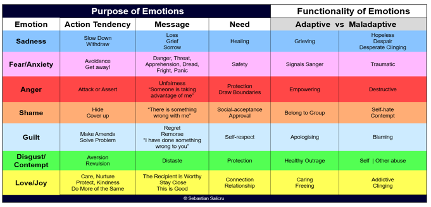Emociones Básicas
Diferentes investigadores clasifican las emociones de forma ligeramente diferente:
Paul Ekman’s la investigación más reciente (Ekman: 2011) identifica siete emociones basicas (anger, surprise, disgust, enjoyment, fear, sadness and contempt); (initially his classification contained six basic emotions, in this work he added one more basic emotion – disgust).
Roberto Plutchik (Plutchik: 1962) propone ocho emociones basicas (ira, anticipación, alegría, confianza, miedo, sorpresa, tristeza y asco), representada en su popular rueda de emociones. Investigadores del Instituto de Neurociencia y Psicología en la Universidad de Glasgow identificar cuatro categorías de las emociones (felicidad, tristeza, miedo/sorpresa y asco/ira).
Cada emoción primaria tiene un propósito y una funcionalidad distintos y puede ser adaptativa (saludable) o desadaptativa (no saludable), como se muestra en la siguiente tabla.
Características de las emociones primarias/básicas
The term “primary emotions” (Damasio, 1994, 131-134) refers to emotions which are supposed to be innate. They developed during human evolution to support fast and reactive response behavior in case of immediate danger, i.e. basic behavioral response tendencies like “flight-or-fight” behaviors.
From a neuroscientific point of view, they “depend on limbic circuitry, the amigdala and anterior cingulate being the prime players” (Damasio, 1994, 133).
So, primary (or basic) emotions are our most fundamental and direct initial reactions to an event or situation (e.g. experiencing sadness following a loss, or fear when perceiving a threat).
Primary emotions – characteristics:
- fundamental para la supervivencia,
- funcionalmente adaptativo,
- innato y universal,
- distintos estados afectivos,
- hardwired in our brains (don’t require learning).
Emociones básicas desde la perspectiva neurocientífica
Fear is a powerful emotion which plays an important role in survival – fight or flight response.
Muchos estudios de fMRI (imágenes por resonancia magnética funcional) respaldan la hipótesis de que la amígdala es el centro más importante en una reacción de miedo (LeDoux, 1998).
Varios aspectos del procesamiento del miedo se han atribuido a la amígdala:
- condicionamiento del miedo (Davis, 1992; LeDoux, 2007),
- iniciación de comportamientos inducidos por el miedo en respuesta a factores estresantes (Weiskrantz, 1956; Blanchard y Blanchard, 1972; Prather et al., 2001; Izquierdo et al, 2005; Machado et al, 2009),
- creación de memoria de estímulos relacionados con el miedo (Cahill et al, 1995; Hamann, 2001).

Anger can be a particularly powerful emotion, characterized by feelings of hostility, agitation, frustration, and antagonism towards others.
Like fear, anger can play a part in your body’s fight or flight response.
Orbitofrontal cortex is the location for anger, because of its relation to prey.
Many fMRI studies suggest that the interaction between orbitofrontal cortex and amygdala is involved in the regulation of anger (Coccaro et al, 2007; Fulwiler et al, 2012).
La actividad de la amígdala está relacionada con la iniciación del miedo, mientras que la corteza orbitofrontal está involucrada en la extinción del miedo (Milad y Rauch, 2007; Siep et al, 2018).

Tristeza: es una emoción provocada por la pérdida y la impotencia (Motoki, Sugiura, 2018), o está relacionada con la imposibilidad de obtener algo deseado (recompensa), o el castigo para obtener cosas dañinas (Gu et al, 2016).
Anterior cingulate cortex (ACC) is related to sadness (Godlewska et al., 2018; Ramirez-Mahaluf et al, 2018a,b). ACC is also linked to sadness because of its role in suffering; many studies have suggested that ACC is also involved in pain or suffering feeling and depression (Taylor et al, 2018).

El sentido de la vida humana está asociado en gran medida a la búsqueda de la felicidad.
Hay dos concepciones diferentes de la felicidad: la felicidad hedónica y la felicidad eudaimónica (Simeng Gu et al, 2019).
- Hedonic happiness is related to physical or psychological pleasure.
- Felicidad eudaimónica está relacionado con el logro de metas personales o con la expresión de nuestro potencial, de nuestras capacidades. (Berridge, Kringelbach, 2011).
Happy events from both kinds activate the ventral prefrontal cortex (including orbitofrontal cortex) (Kringelbach, 2005).
In a functional magnetic resonance imaging (fMRI) experiment, Rolls et al. (2008) found that activations in the ventral prefrontal cortex, the cingulate cortex, and the ventral striatum were associated with the positive hedonic state.

La emoción de asco se experimenta típicamente como un sentimiento de repugnancia provocado por estímulos ofensivos, ya sea en el aspecto físico o moral.
no hay consenso entre los neurocientíficos sobre la región del cerebro responsable del procesamiento del asco, así como sobre la naturaleza de esta emoción en sí.
Some researchers defend the opinion that the insula is the location of disgust processing and that it differs from anger and fear, while others, on the basis of meta-analysis of imaging data, found that the anterior insula is not more active during disgust processing than when processing other emotions, such as anger (Wager et al, 2007; Oaten et al, 2018a,b).

La emoción sorpresa alerta al individuo de cualquier desviación de las expectativas, independientemente del valor del resultado (Litt et al, 2011; Fouragnan et al, 2018).
According to meta-analyses of fMRI studies, surprise induced brain regions are predominantly subcortical, including the amygdala and striatum, as well as some cortical regions, such as the ventromedial prefrontal cortex and the cingulate cortex (Behrens et al, 2009; Bartra et al, 2013).



